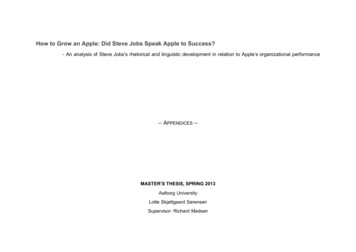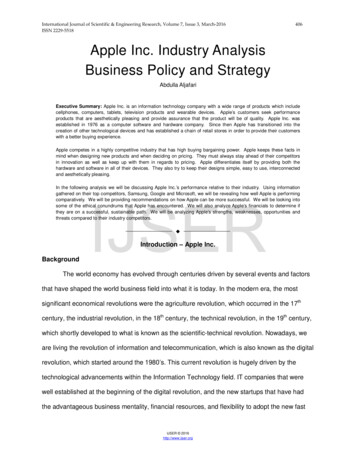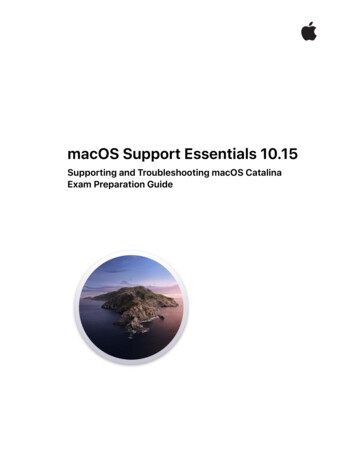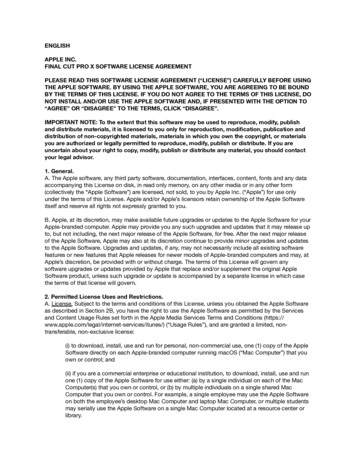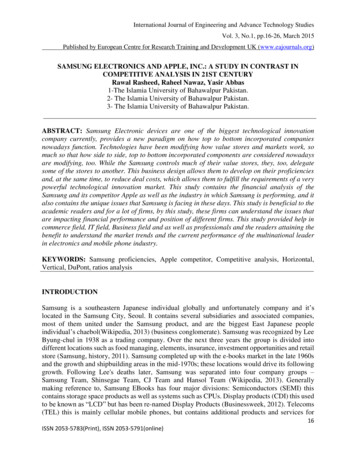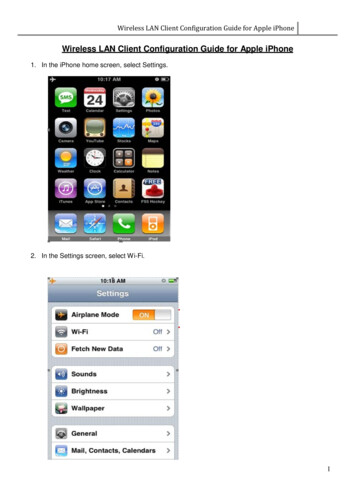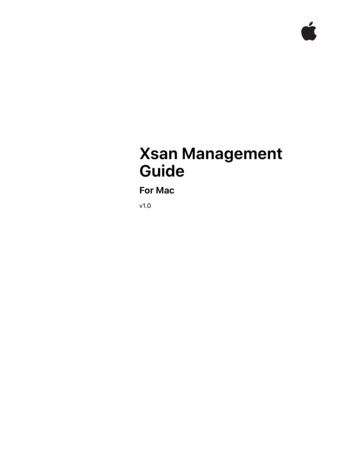
Transcription
Xsan ManagementGuideFor Macv1.0
ContentsIntroduction3About Xsan SANs4How Xsan storage is organized6How Xsan uses available storage7Xsan hardware requirements8Xsan network requirements9Plan your Xsan SAN11First-time Xsan SAN setup17Manage Xsan volumes21Manage access to SAN content22Manage controllers23Add a Mac client to a Quantum SAN242Xsan Management Guide2021
IntroductionThis guide provides basic command-line instructions on how toconfigure and manage an Xsan storage area network (SAN).Before you begin, familiarize yourself with two command-linetools, cvlabel and xsanctl. You can do this by opening theTerminal app and typing man cvlabel, then pressing the Returnkey. This displays the manual page for the cvlabel command.You can do the same with the xsanctl command.IMPORTANT: You should feel comfortable with using the Terminal app andhave a basic understanding of how to navigate directories and use the sudocommand. Not setting up the SAN properly or making changes incorrectlycould cause failures or loss of data.3Xsan Management Guide2021
About Xsan SANsA storage area network (SAN) is a way of connecting computers and storagedevices so computers have fast, shared access to files while making it easy foradministrators to expand storage capacity.An Xsan SAN consists of: Shared data volumes RAID systems that provide storage space that’s protected from disk failure At least one computer acting as a metadata controller that combines RAIDarrays and presents their storage to clients as volumes that behave like localdisks Client computers that access storage in accordance with establishedpermissions and quotas Underlying fibre channel, Distributed LAN Client, and Ethernet networksShared SAN volumesA user or app on a client computer accesses shared SAN storage as if it were alocal volume. Xsan volumes are logical disks made up of pools of RAID arrays.Metadata controllersWhen you set up an Xsan SAN, you assign at least one computer to act as themetadata controller. The controller manages volume metadata, maintains a filesystem journal, and controls concurrent access to files. Metadata includes suchinformation as where files are stored and what portions of available storage areallocated to new files.To guarantee volume availability, a SAN should include more than one metadatacontroller. In this way, if the active controller fails, a standby controller takesover.ClientsThe computers that users or apps use to access SAN volumes are calledclients. Clients exchange metadata with controllers over an Ethernet network,but use fibre channel or Distributed LAN Client (DLC) to send and retrieve filedata to and from the RAID systems that provide storage for the volumes.Fibre channel network connectionXsan moves data between clients and SAN volumes over high-speed fibrechannel connections. Controllers also use a fibre channel connection to movemetadata to and from the volume.Xsan can take advantage of multiple fibre channel connections between clientsand storage. Xsan can alternate between connections for each read and write,or it can assign each RAID array in a volume to a connection when the volume ismounted.4Xsan Management Guide2021
Ethernet network connectionAll versions of Xsan exchange file system metadata over an Ethernet network.(Controllers use fibre channels to read and write metadata on a volume.) Toprevent internet or intranet traffic from interfering with metadatacommunications, you can optionally set up separate public (internet) andprivate (metadata) Ethernet networks.Distributed LAN Client (DLC) network connectionXsan 4.1 or later on OS X 10.11 or later supports StorNext’s DLC networkconnection, which allows client connections to your SAN over Ethernet insteadof a fibre connection. Connections for such tasks as ingesting and editing cantake place over fibre, while DLC connections can be used for other tasks.You can have a public network (internet), a private network (metadata), and aDLC network all as independent networks, with optimum performance. Youcould instead have all three over a single wired Gigabit Ethernet connection, butthroughput won’t be optimum.Note: macOS only supports being a client using DLC. Being a metadatacontroller isn’t supported.Xsan securityThere are several ways you can control access to a SAN volume: Unmount a volume on client computers that shouldn’t have access to it (usingthe xsanctl command-line tool). However, users who have administratoraccounts on client computers can browse and mount SAN volumes. Specify owner, group, and general access permissions in the Finder. Control user access to files and folders on a volume, by setting up accesscontrol lists (ACLs). This works only if access controls lists are enabled for avolume.5Xsan Management Guide2021
How Xsan storage is organizedAlthough an Xsan volume mounted on a client computer looks like a single disk,it consists of multiple physical disks combined on several levels using RAIDtechniques. The following paragraphs describe these elements and how youcombine them to create shared Xsan volumes.LUNsThe smallest storage element you work with in Xsan is called a SCSI logical unitnumber, or LUN. A LUN represents a group of drives combined into a RAIDarray.You create a LUN when you create a RAID array on a RAID storage device. TheRAID system combines physical drives into an array based on the RAID schemeyou choose. Each array appears on the fibre channel network as a LUN. If thestandard RAID arrays on your RAID systems aren’t right for your application, youcan use the RAID system management software to re-create arrays based onother RAID schemes or different numbers of drive modules.Your RAID LUNs are labeled and initialized for use with the Xsan file systemwhen you use cvlabel to label the LUNs. The addVolume command usesthose labels to create the Xsan volume. For more information, launch theTerminal app and enter man cvlabel, then press Return.Storage poolsLUNs are combined to form storage pools. A storage pool in a small volumemight consist of a single RAID array, but a larger volume might consist ofseveral storage pools each of which includes several arrays.Xsan distributes file data in parallel across the LUNs in a storage pool using aRAID 0 (striping) scheme. By distributing available storage over several LUNs ina storage pool, so you can improve a client’s access speed. You can set upstorage pools that have different performance or recoverability characteristicsbased on the RAID level of their LUNs. Users can then select where to store filesbased on their need for speed or safety. When you create or modify a storagepool, the number of assigned LUNs needs to be a power of 2.You can add LUNs to storage pools and storage pools to Xsan volumes at anytime. You use xsanctl editVolume to add available LUNs to storage pools.For more information, launch the Terminal app and enter man xsanctl, pressReturn, then locate the Storage Pool settings section.VolumesStorage pools are combined to create the Xsan volumes that users see. Fromthe user’s perspective, the volume looks and behaves like a large local volume,except that: The size of the volume can grow as you add underlying arrays or storagepools Multiple users on the SAN can access files on the volume at the same time6Xsan Management Guide2021
How Xsan uses available storageXsan stores user files and file system data on SAN volumes, and stripes dataacross the LUNs in a volume for better performance.Metadata and journal dataXsan records information about the files in an Xsan volume using metadata filesand a file system journal. File system metadata includes information such aswhich specific parts of which disks are used to store a file and whether the fileis being accessed. The journal data includes a record of file system transactionsthat help ensure the integrity of files in the event of a failure.These files are managed by the Xsan metadata controller but are stored onLUNs, not on the controller itself. Metadata should be stored on the first storagepool you add to a volume. Journal data can also be stored on the same storagepool as metadata, or you can use a separate storage pool for journal data. Youmust have journal data on only one storage pool.Striping at a higher levelWhen a RAID system writes a file using a RAID 0 (striping) scheme, it breaks thefile into segments and spreads them across disk drives in the RAID array. Thisimproves performance by writing parts of the file in parallel (instead of one partat a time) to disks in the array.Xsan applies this same technique in the storage hierarchy. Within each storagepool in a volume, Xsan stripes file data across the LUNs that make up thestorage pool. Performance is improved because data is written in parallel.You can tune SAN performance by adjusting the type of data written to eachLUN in a storage pool (mixing or separating metadata, journal data, and userdata).Xsan capacitiesThe following table lists limits and capacities for Xsan volumes.ParameterMaximumNumber of volumes on a SAN16Number of storage pools in a volume512Number of LUNs in a storage pool32Number of LUNs in a volume512Number of les in a volume4,294,967,296LUN sizeLimited by the size of the RAID arrayVolume sizeLimited by the number and size of LUNsFile sizeApproximately 263 bytesVolume name length70 characters (A–Z, a–z, 0–9, and )File or folder name length251 ASCII charactersStorage pool name length255 ASCII charactersLUN name (label or disk name)242 ASCII characters7fiXsan Management Guide2021
Xsan hardware requirementsTo join a specific version of Xsan, computers must meet the following minimumrequirements.Xsan version requirements If you’re using macOS 11 or later, you have Xsan 7. If you’re using macOS Server 5.4 or later on macOS 10.13 or later, you haveXsan 5. If you’re using macOS Server 5.2 or later on macOS 10.12, you have Xsan 5. If you’re using macOS Server 5.2 on OS X 10.11.6, you have Xsan 4.1.Memory requirements Client computers must have at least 4 GB of RAM. Computers used as metadata controllers must have at least 8 GB of RAM andone SAN volume, plus 2 GB of RAM for each additional SAN volume hosted bythe controller.For example, a controller should have 8 GB of RAM to host one volume, or 10GB for two volumes.Supported operating systems Computers with macOS 11 can be used as Xsan 7 metadata controllers andclients. Computers with macOS 10.12 through 10.15 can be used as Xsan 5 metadatacontrollers and clients. To join an Xsan SAN, Windows, AIX, IRIX, Linux, and Solaris clients must berunning Quantum’s StorNext File System.Supported storage devices Use only Apple-qualified RAID systems or ALUA-compliant RAID systems forstorage devices.IMPORTANT: Be sure to install the latest firmware update on your RAIDsystems before you use them with Xsan.8Xsan Management Guide2021
Xsan network requirementsFibre channel connectionsUnlike file system metadata, which is exchanged over Ethernet, file content inan Xsan SAN is transferred over fibre channel connections. The computers,storage devices, and switches are connected with fibre channel cables to forma fibre channel fabric. To set up the connections, you need a supported fibrechannel adapter for each client and controller computer, a supported fibrechannel switch, and fibre channel cables connecting computers and storagedevices to the switches to form a fibre channel fabric. Fibre channel cards or adapters: Install a fibre channel PCI card or attach afibre channel adapter to a compatible port of each Mac that connects to theSAN.Note: If you’re using a Mac with Apple silicon, you may need to allow theinstallation of kernel extensions for your fibre card or adapter. For moreinformation, see Kernel extensions in macOS in the Deployment Reference forMac. Fibre channel switches: Use fibre channel switches from Brocade, Cisco, andQLogic; these have been tested with Xsan. Fabric configuration: You must connect the computers, storage devices, andswitches in your fibre channel network to form a fibre channel fabric. In afabric, fibre channel cables connect node ports (F or N Port). For moreinformation about setting up your fabric, see the documentation that camewith your fibre channel switches.DLC connectionsFor Distributed LAN Client (DLC) connections, computers on the SAN must usemacOS 10.13 or later connected to an Ethernet network. DLC devices for eachcomputer can be purchased from Quantum.Ethernet TCP/IP network connectionsComputers on the SAN must be connected to an Ethernet network. Xsancontrollers and clients use this network instead of the fibre channel network toexchange file system metadata. Using IP addresses: The client and metadata controller computers need static(fixed) IP addresses for Ethernet network connections. For the public intranetand internet connection, you can enter each computer’s static IP address,subnet mask, router address, and DNS server address manually or configure aDHCP server to provide this information. Using DHCP: If you want the DHCP server to provide IP addresses, it mustalways assign the same static IP address to each SAN computer. Don’t useDHCP to assign dynamic IP addresses to SAN devices. Private addressing: For the SAN metadata network, the SAN computersshould have static private (nonroutable) IP addresses (unless you can’t set upa separate, private Ethernet network for SAN metadata).9Xsan Management Guide2021
Directory servicesTo use Xsan, you must have an Open Directory infrastructure on the metadatacontrollers. The first metadata controller activated will be made an OpenDirectory master, and all additional controllers must be Open Directory replicas.If the SAN had Open Directory services active before the SAN was created, theOpen Directory Master (Xsan 2 or 3 Primary MDC for SANs that managed usersand groups) must be upgraded and activated first using Open Directoryprocedures.The directory is also used to manage user and group privileges to controlaccess to files and folders on the SAN. A central directory service lets youmanage SAN users and groups from one computer instead of having to visit andpainstakingly configure each SAN client and metadata controller.If you have another type of directory service, such as Active Directory, youconfigure each Mac in the SAN to connect to it for user and group accounts byusing the Users & Groups pane of System Preferences after initial setup. If yourSAN doesn’t have access to an existing directory service, xsanctlcreateSAN creates an Open Directory master server on your initial (primary)metadata controller.The Open Directory master provides an LDAP directory, single sign-on userauthentication using Kerberos, and password validation using commonauthentication methods. The replicas improve responsiveness and provideautomatic failover of Open Directory services.10Xsan Management Guide2021
Plan your Xsan SANIt’s easy to add storage to an Xsan SAN, but reorganizing a SAN after you set itup isn’t simple. So, it’s important to plan the layout and organization of yourSAN and its storage before you set it up.An Xsan SAN is made up of: Storage devices (RAID systems) LUNs (SCSI logical unit numbers, usually RAID arrays) Storage pools (groups of LUNs) Volumes (groups of storage pools visible to users) Clients (computers that use volumes) Controllers (computers that manage volume metadata) An Ethernet network used to exchange volume metadataBefore you set up a SAN, you must decide how to organize these components.Take the time to create a diagram or a table that organizes available hardwareinto RAID arrays, volumes, client computers, and metadata controllers in a waythat meets SAN users’ needs and your needs as the SAN administrator.Preliminary planningAs you plan, consider the following questions: How much storage do you need? How do you want to present available storage to users? What storage organization makes the most sense for your users’ workflow? What levels of performance do users require? How important is high availability? What are your requirements for security?Your answers to the questions above will help you decide the following: What RAID schemes should you use for your RAID arrays? How many SAN volumes do you need? How should individual volumes be organized? Which clients, users, and groups should have access to each volume? Which computer will act as the primary metadata controller? Do you need more than one standby metadata controller? Do you need to adjust a volume’s allocation strategy? How should you configure your Ethernet network?How much storage?Because it’s easy to add storage for user data to an Xsan SAN, you only need anadequate starting point. You can add storage later as needed. However, you11Xsan Management Guide2021
can’t add storage for journal data, so try to allocate enough space for journaldata right from the start. You can add an entire storage pool for metadata andanother storage pool for journal data.Workflow considerationsHow much file sharing is required by your users’ workflow? For example, ifdifferent users or groups work on the same files, simultaneously or in sequence,store those files on a single volume to avoid needing to maintain or hand offcopies. Xsan uses file locking to manage shared access to a single copy of thefiles.Performance considerationsIf your SAN supports an app (such as high resolution video capture andplayback) that requires the fastest possible sustained data transfers, designyour SAN with these performance considerations in mind: Set up the LUNs (RAID arrays) using a RAID scheme that offers highperformance. Use RAID 1 for metadata LUNs and RAID 5 for data LUNs. To increase parallelism, spread LUNs across RAID controllers. Xsan thenstripes data across the LUNs and benefits from simultaneous transfersthrough two RAID controllers. To increase throughput, connect both ports on client fibre channel cards tothe fabric. For clients using Xsan 5 or Xsan 7 and DLC, real-time operations should bedone over a fibre connection. Store file system metadata on a separate storage pool from user data andmake sure the metadata LUNs aren’t on the same RAID controller as user dataLUNs. You can use a separate storage pool for journal data when you create a newvolume. This significantly improves performance for some operations, such ascreating and deleting files. Use a second Ethernet network (including a second Ethernet port for eachSAN computer) for SAN metadata.Availability considerationsIf high availability is important for your data, set up multiple metadatacontrollers to accommodate metadata controller failover. Also, consider settingup dual fibre channel connections between each client, metadata controller,and storage device using redundant fibre channel switches.Security considerationsIf your SAN supports projects that must be secure and isolated from each other,create separate volumes for each project and set appropriate ACLs on thevolume to eliminate any possibility of the wrong client or user accessing filesstored on a volume.12Xsan Management Guide2021
As the SAN administrator, you control which computers are SAN clients. Userswhose computers aren’t SAN clients or controllers can’t browse for or mountSAN volumes.However, you can’t control which Xsan computers can use a volume. Userswhose SAN computers have macOS can mount all SAN volumes themselves.You can also set up access control lists (ACLs) or assign user and grouppermissions to folders using standard file access permissions in the Finder.Prepare LUNs using RAID arraysMuch of the reliability and recoverability of data on a SAN is provided not byXsan but by the RAID arrays you combine to create storage pools and volumes.Before you set up a SAN, use the RAID system configuration or administrationsoftware to prepare LUNs based on specific RAID schemes.WARNING: Losing a metadata controller without a standby metadata controllercan result in the los
but use fibre channel or Distributed LAN Client (DLC) to send and retrieve file data to and from the RAID systems that provide storage for the volumes. Fibre channel network connection Xsan moves data between clients and SAN volumes over high-speed fibre channel connections. Controllers als
